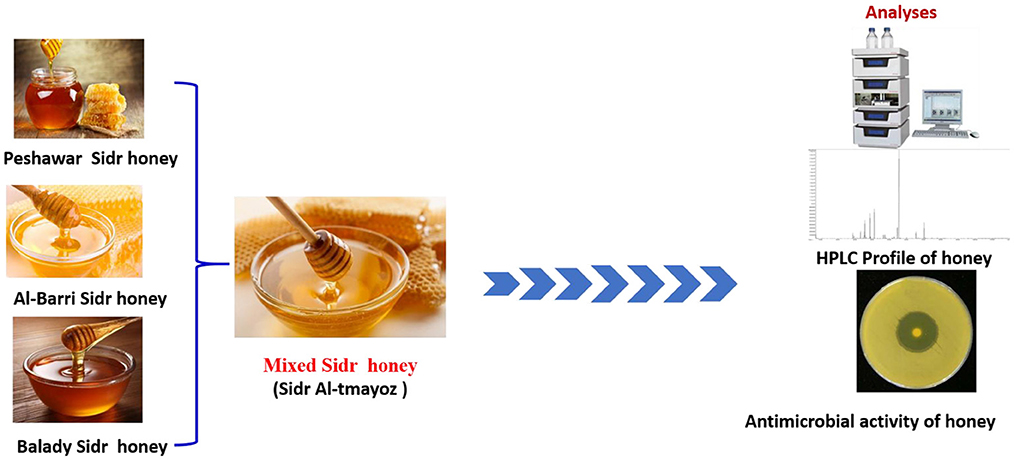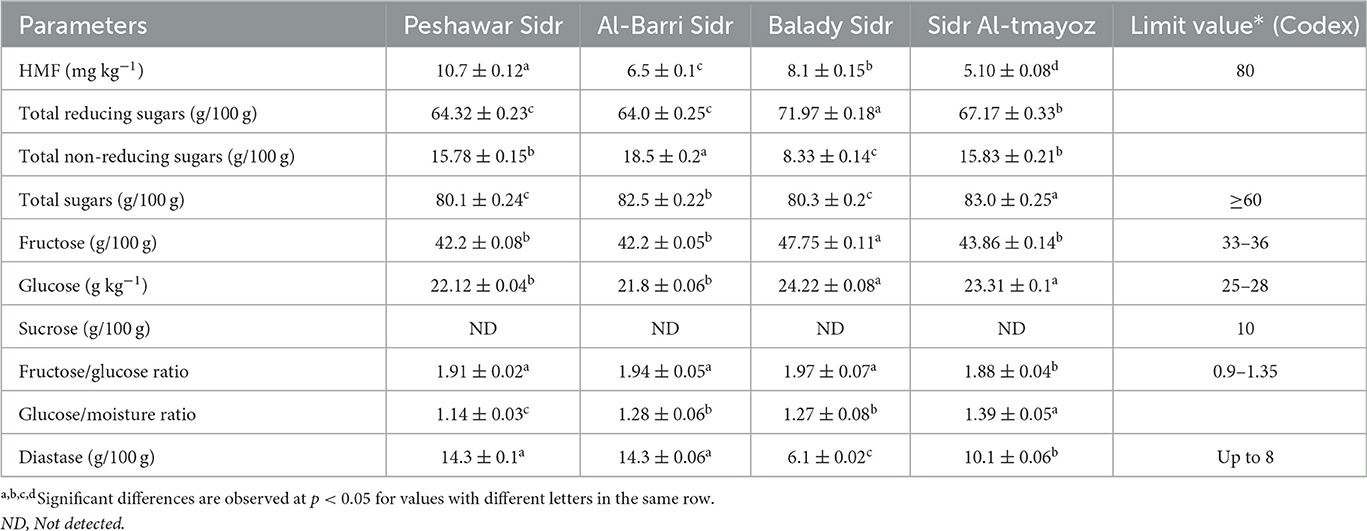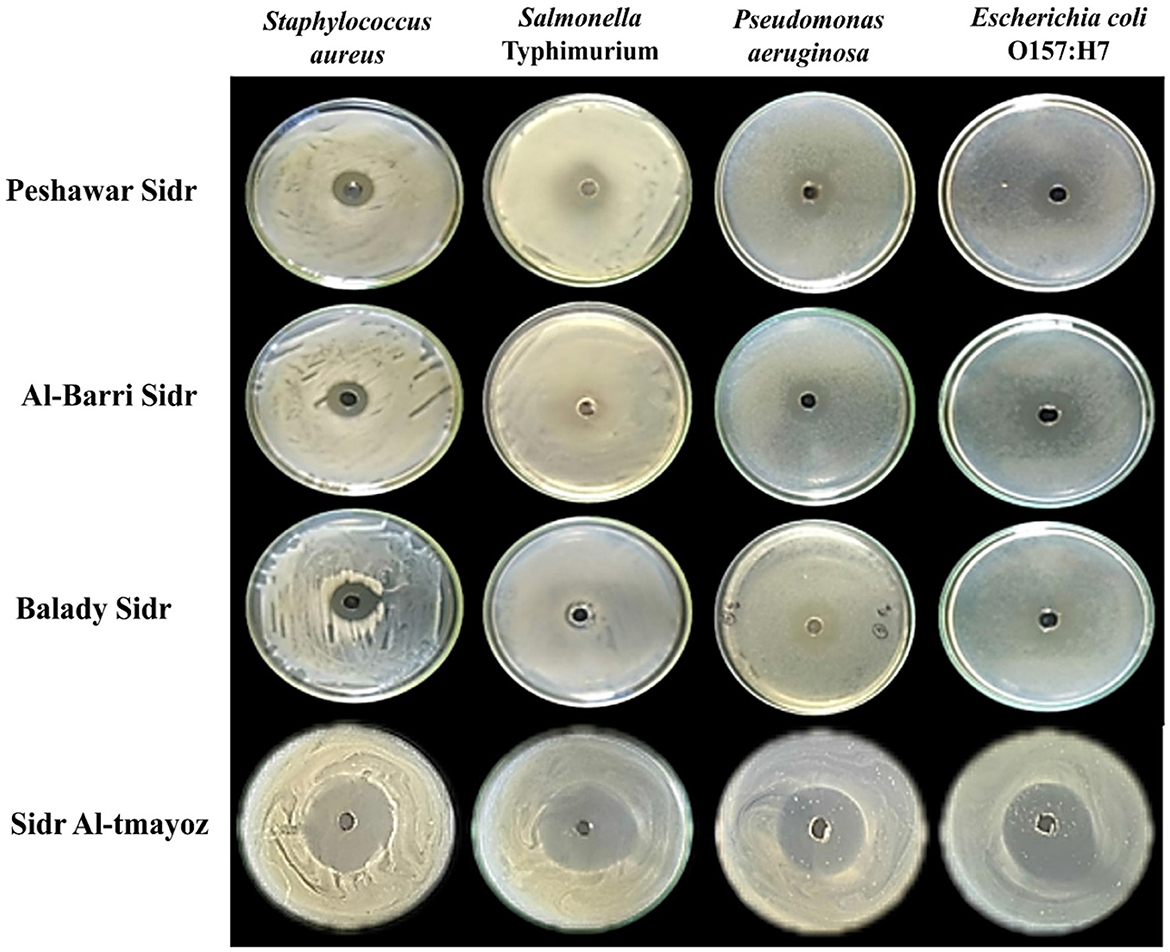- 1Agricultural Microbiology Department, Faculty of Agriculture, Benha University, Qaluobia, Egypt
- 2Department of Food Technology, Faculty of Agriculture, Benha University, Qaluobia, Egypt
- 3Api Pharm Company, Menofia, Egypt
- 4Consultant Al-Asal Al-Barri Company, Riyadh, Saudi Arabia
- 5Al-Asal Al-Barri Company, Riyadh, Saudi Arabia
- 6Central Laboratory of Residue Analysis of Pesticides and Heavy Metals in Food, Department of Microbiology, Agriculture Research Center, Giza, Egypt
- 7Department of Chemistry, Faculty of Sciences, University of Hafr Al Batin, Hafr Al Batin, Saudi Arabia
- 8Plant Protection Department, Faculty of Agriculture, Benha University, Qaluobia, Egypt
Introduction: Sidr honey has been used for centuries for its taste, odor, nutritive value, and therapeutic characteristics, including antibacterial and antioxidant activity. Sidr honey is high cost, and limited supply leads to frequent tampering. Honey's quality is established by its botanical origin and chemical composition, which, depending on whether it is categorized as organic, monofloral, or multifloral, are also utilized to increase sales. This study evaluated the quality parameters and antioxidant capacity of mixed Sidr honey (Sidr Al-tmayoz).
Methodology: Physicochemical, antibacterial properties, and antioxidant capacity of mixed Sidr honey (Sidr Al-tamayoz) from Saudi Arabia were performed. The Sidr Al-tamayoz was designed using three types of Sidr honey, i.e., Peshawar Sidr, Al-Barri Sidr, and Balady Sidr (1:1:1; w/w). physicochemical including pH level, total insoluble solids, hydroxymethylfurfural, hydroxymethylfurfural, sugars, diastase enzyme activity were carried out. Bioactive compounds that is, flavonoids and phenolics, also antioxidant activity (DPPH) were done. Additionally, antibacterial capacity was conducted using agar well diffusion assay.
Results and discussion: The physicochemical properties of Sidr Al-tamayoz honey were moisture (16.7%), pH (5.07), acidity (20 meq/kg), electrical conductivity (0.85 mS/cm), hydroxymethylfurfural (5.1 mg/kg), and total sugars (83 g/100 g) in accordance with Codex Alimentarius. Sidr Al-tamayoz honey exhibited high phenolic (45.76 mg GA/g), flavonoid (40.66 mg R/g), and antioxidant activity (62.68%). Moreover, Sidr Al-tamayoz displayed the greatest antibacterial activity (inhibitory zones and dehydrogenase activity) out of all the pathogenic bacteria: Staphylococcus aureus, Salmonella Typhimurium, Pseudomonas aeruginosa, and Escherichia coli O157:H7.
Conclusion: The findings demonstrated that Sidr Al-tamayoz honey is a promising natural product rich in bioactive compounds and antioxidants, as well as enhancing quality parameters.
Introduction
Bee honey is a genuine gift from nature because of its unique flavor and amazing medicinal qualities; it is the most well-known and significant product of the honeybee (Apis mellifera) (Kumar, 2024). For millennia, honey has been employed as a natural sweetener or flavoring, and it is highly valued and frequently consumed (Predanócyová and Šedík, 2024). Its complex composition includes ~200 compounds, such as carbohydrates, enzymes, proteins, minerals, vitamins, phenolic compounds, and organic acids (Wilczyńska and Żak, 2024). Honey seems to possess antimicrobial, antidiabetic, anti-inflammatory, anti-obesity, and wound-healing properties (Mashal et al., 2023; El-Seedi et al., 2024). Global honey production reached 1.88 million tons in 2018. With 44% of the world's production, Asia is the continent that produces the most, followed by Europe (24%), the Americas (19%), Africa (11%), and Oceania (2%) (2%) (FAO, 2024; Marchese, 2024). The value of honey exports is around $2 billion USD (FAO, 2024).
Sidr honey, a monofloral honey produced from Ziziphus species, is becoming more well-known after Manuka honey (Bouddine et al., 2024). Sidr, also called Jujuba, is primarily distributed in the arid regions of Yemen, Saudi Arabia, Egypt, Libya, and Pakistan (Ibrahim et al., 2024). Sidr honey is a high cost product with a limited supply leads to frequent tampering (Dar et al., 2024). Honey's quality is established by its botanical origin and chemical composition, which, depending on whether it is categorized as organic, monofloral, or multifloral, are also utilized to increase sales (Rosa et al., 2024).
Numerous studies have demonstrated the broad antibacterial activity of honey from different geographical locations; nonetheless, the honey's source significantly affects how effective it is (Ogwu and Izah, 2025). Additionally, studies have demonstrated that the antibacterial qualities of honey vary depending on the type of bloom and may even vary within the same floral source (Luca et al., 2025). Nectar, pollen, and propolis are among the basic ingredients that bees are known to gather to produce honey. Certain constituents of these raw ingredients possess significant antimicrobial qualities that can enhance honey's overall antimicrobial efficacy (Betta et al., 2024). Honey's antibacterial activity have been studied in relation to a number of diseases, including viruses (Luca et al., 2024), fungi and yaests, (Hao et al., 2022), Gram-positive and Gram-negative bacteria (Faleiros-Quevedo et al., 2025), and multidrug-resistant bacteria (Ogwu and Izah, 2025).
Honey naturally contains hydrogen peroxide, as bees collect glucose oxidase from nectar, which converts glucose into gluconic acid and hydrogen peroxide. Hydrogen peroxide acts as an antimicrobial agent through several mechanisms, including disrupting bacterial membranes and generating reactive oxygen species (ROS), which lead to protein oxidation and DNA strand breakage (Xie and Coghi, 2025). However, the antimicrobial effect of hydrogen peroxide may be suppressed or enhanced by the presence of other honey compounds.
On the other hand, honey is a highly concentrated (hyperosmotic) sugar solution with low water content and a low water activity (aw) of ~0.5–0.6. Microbes cannot divide or grow in such dry conditions, as most bacteria and fungi require an (aw) of >0.9. As well, its high sugar content makes it hypertonic compared to microbial cells, resulting in a strong osmotic effect that draws water from the microbial cells, leading to their dehydration and death. Furthermore, the osmotic pressure of honey works in conjunction with its acidity, hydrogen peroxide, bee-derived peptides, phytochemicals (phenols and flavonoids), and enzymes to kill or inhibit microbes (Khataybeh et al., 2023). In one study, Hegazi et al. (2017) collected 10 types of monofloral honey from Saudi Arabia. They examined them against 5 Gram-negative (Klebsiella pneumoniae, Escherichia coli, and Pseudomonas aeruginosa) and Gram-positive (Staphylococcus aureus and Streptococcus mutans) bacteria. The antibacterial properties of various honey varieties varied depending on the type of bacteria they were tested against. Alqurashi et al. (2013) assessed the effectiveness of the antimicrobial properties of regional Sidr and mountain honey from Saudi Arabia against a number of human diseases and discovered that Sidr honey was more effective against Gram-negative bacteria (E. coli). Honey has been shown to reduce inflammation and oxidative stress while promoting the healing process due to its biochemical composition, which includes a wide range of antioxidants (Wilczyńska and Żak, 2024).
A unique method for creating new honey products is mixed Sidr honey (Sidr Al-tamayoz). Different types of honey contain distinct antibacterial compounds, and blending honey combines their active components, creating a broader, more potent antimicrobial effect. This helps target multiple microbial pathways, such as osmotic stress, oxidative damage, membrane disruption, and enzyme inhibition. Mixing honey may mimic multidrug therapy, reduce the chance of microbial resistance, and enhance efficacy. Furthermore, the honey mixture ensures that minor compounds, which may be negligible in one honey, contribute significantly when pooled. Furthermore, some honey may lack critical antibacterial agents (low peroxide activity or flavonoid). A mixture fills these gaps, making the final product more robust and effective. Sidr Al-tamayoz will improve the honey's quality attributes. Additionally, Sidr Al-tamayoz will compile distinct descriptions of Sidr honey from different botanical origins and geographical locations. Sidr Al-tamayoz will also provide a number of nutritional and physiological advantages. Honey from various botanical sources differs significantly in chemical composition, physical properties, sensory features, and medicinal benefits.
Previous studies did their best to identify and monitor the quality of Sidr honey, but there are no studies focused on mixed Sidr honey (Sidr Al-tamayoz). Therefore, the study aimed to (i) determine the physicochemical properties of mixed Sidr honey and (ii) evaluate the impact of mixed Sidr honey on antimicrobial activity and antioxidant capacity.
Materials and methods
Honey samples
Three kinds of Sidr honey, i.e., Peshawar Sidr, Al-Barri Sidr, and Balady Sidr, were collected in 2024 from the local market in Riyadh, Saudi Arabia. The samples were transported to the laboratory in a carton box within 30 min to the Nahal association. The honey samples were kept in glass jars in the cold-dark condition until used for preparation and analysis.
Bacterial strains
Four bacterial strains, Staphylococcus aureus (ATCC 20231), Salmonella Typhimurium (ATCC 14028), Pseudomonas aeruginosa (ATCC 9027), and Escherichia coli O157:H7 (ATCC 6933), were obtained from the Agricultural Microbiology Department, Benha University, Cairo, Egypt. Tryptic soy broth (TSB; Biolife, Italy) was used to activate the bacteria, and they were then grown in the same medium for 24 h at 37 ± 1?C. By counting on tryptic soy agar, the bacterial population of ~6 log10 CFU mL−1 (CFU) was verified.
Preparation of mixed Sidr honey (SidrAl-tamayoz)
Mixed Sidr honey (Sidr Al-tamayoz) was prepared by mixing three types of honey, i.e., Peshawar Sidr, Al-Barri Sidr, and Balady Sidr (1:1:1, w/w), using a homogenizer at 25°C in the Nahal association, Saudi Arabia. The samples were placed in glass jars (250 g) and dark conditions until analysis (Figure 1).
Physicochemical properties
The pH level was determined by a pH meter (M21, Boeco, Germany), and electrical conductivity (EC; mS/cm) was measured in 20% (w/v) honey solution tested using an Ino lab conductometer (M21, Boeco, Germany) according to AOAC (2016). Total insoluble solids were estimated by an oven at 105°C, and free lactone and acidity were determined by a titrimetric method according to AOAC (2016). Hydroxymethylfurfural (HMF) of aqueous honey solution was analyzed using HPLC (Smart line, Knauer, Germany) (Shapla et al., 2018). The total and reduced sugars were estimated according to AOAC (2016). Glucose, fructose, and sucrose contents were determined using HPLC (Phenomenex® Luna NH2 250X4.6 mm) according to the standard methods (Zhou et al., 2014).
Diastase enzyme activity (DEA)
Diastase activity was measured using spectrophotometric (UV/Vis spectrophotometry, Jenway, England) at 620 nm according to the Phadebas method (Schade et al., 1958). The findings are given in Schade units as diastase number (DN). The enzyme capacity of 1 g of honey is equivalent to one unit, which can hydrolyze 0.01 g of starch in 1 h at 40°C and pH 5.2. DN was calculated using Equation 1:
Phenolic and flavonoid compounds
According to Bertoncelj et al. (2007), the Folin-Ciocalteu method was used to measure the total phenolic (TP) of honey at 750 nm. In brief, 2 mL of Na2CO3 (20%; w/v) was added to 3 mL of distilled water (DW) after 200 mL of honey (1 mg mL−1) had been gently mixed with Folin reagent (0.5 mL/3 min), then the mixture was measured at 750 nm. Gallic acid equivalent (GAE) of TP was expressed as 1 milligram per 100 grams of honey. As elucidated by Shraim et al. (2021), the colorimetric measurement of honey's total flavonoid (TF) was conducted at 510 nm. Briefly, 50 mL of honey (1 mg/mL) was added to 1 mL of methanol, followed by 4 mL of DW, 0.3 mL of 5% (w/v) NaNO2, and 0.3 mL of 10% (w/v) AI CI3 after 5 min of incubation. The mixture was then left for 6 min, and then 2 mL of NaOH (1 mol/L) was added. Double-DW was used to reduce the mixture's final volume to 10 mL. The absorbance at 510 nm was measured after the mixture was left for 15 min. The amount of rutin equivalents (RE) per gram of honey was used to calculate the TF. Three separate analyses were carried out.
Antioxidant activity (AA)
Honey's capacity to scavenge 1,1-diphenyl-2-picrylhydrazyl (DPPH) radicals was evaluated using the methodology described by Chua et al. (2013). The 200 μL of honey and 3.8 mL of DPPH solution were combined, and the mixture was left to sit at ambient temperature in the dark for 60 min. The mixture was measured at 517 nm, and the positive control, or BHT, was conducted. AA was calculated as the following Equation 2:
Honey's antimicrobial properties
Agar well-diffusion assay
On sterile N-agar plates, 1 milliliter of each pathogenic S. aureus, S. typhimurium, P. aeruginosa, and E. coli O157:H7 bacterial inoculum was applied. A measure of 50 μL of honey was added to each well after 7-mm diameter wells were cut out of the middle of the plates using a sterile cork-borer. The plates were incubated for 1 h at ambient temperature and then for 24 h at 37°C. Three duplicates of each honey concentration −25, 50, and 100%—were used in this experiment. For the negative control, sterilized distilled water was used (Jaradat et al., 2022).
Microbial growth
To achieve different concentrations (15, 25, 50, and 75%), honey were serially diluted twice with the nutrient broth in tubes. A 1 mL of bacterial inoculum that was 24 h old (106 CFU/mL) was added to 9 mL of each concentration (Doughari, 2006). Then the tubes were incubated for 24 h at 37°C. The following activities were estimated.
Bacterial growth curve
Nine milliliters per tube were used to split the dilutions into tubes. Each tube was then filled with 1.0 mL of the pathogenic bacteria culture, which was then incubated for 48 h at 37°C. At 0 time, 12, 24, 36, and 48 h, the optical density at 600 nm was measured. As a positive control, bacterial cultures devoid of honey were used (Burdock et al., 2011; Hamoda et al., 2021).
Dehydrogenase activity (DHA)
After pipetting 1 milliliter from each prepared tube into four test tubes, each tube was filled with 1.0 milliliter of TTC-glucose solution (1.0 gram of glucose and 2.0 grams of TTC dissolved in 100 milliliters of distilled water) and 2.5 milliliters of 0.1 M Tris buffer (12.42 grams of hydroxyl methyl amino-methane in 373 milliliters of HCl 0.2 N and made up to 1 liter, pH 7.8). In place of the sample, distilled water was used as the control. The HCl solution (1 N) was added to get the final pH down to 7, and the tubes were then carefully Sidr Al-tamayoz. The tubes were centrifuged for 10 min at 5,000 rpm after being incubated for 1 h at 37°C (Burdock et al., 2011). DHA was calculated using the following Equation 3:
Statistical analysis
The analysis of variance (ANOVA) and post-hoc Tukey for mean comparison were used to identify significant differences between samples. The IBM SPSS statistical program was used for all statistical studies. A p-value of ≤ 0.05 was deemed significant.
Results and discussion
Physicochemical parameters
The physicochemical properties of honey are valuable indicators for both botanical origin identification and quality assessment. Table 1 presents the moisture, pH, free acidity, lactone, total acidity, and electrical conductivity (EC) of the honey samples. Since moisture content is important for fermentation, it can be used as a parameter to assess a food's vulnerability to deterioration. The moisture content of honey samples ranged between 16.7 and 19.4% for Sidr Al-tamayoz and Peshawar, respectively. According to the Codex Alimentarius, honey must have no more than 20% moisture (Codex, 2022). This indicates all samples are within the permissible limits. Previous studies found that the moisture content of Yemen Sidr honey ranged 13.4–16.0% (Roshan et al., 2017), Saudi Arabia Sidr honey 18.0% (Hegazi et al., 2022), Omani Sidr honey ranged from 13.7 to 18.8% (Al-Farsi et al., 2018), and Egyptian Sidr honey was 19.0% (Omran et al., 2023). The variance in honey moisture content is due to honey's varieties, weather, and maturity level (Taha et al., 2021). The pH values of Balady honey and Al-Barri honey ranged from 4.7 to 5.5, respectively. Based on the Codex standard, the pH value ranged from 3.7 to 6.0 according to regional variation (Chakir et al., 2016), which revealed that the pH levels of Moroccan honey ranged between 3.2 and 5.0 (Guerzou et al., 2021). pH values in Algerian honey were between 3.5 and 5.1. Hegazi et al. (2022) investigated 794 Sidr honey samples imported into the Saudi market from 12 different nations and discovered that the pH values varied between 5.4 (Saudi Arabia), 3.6 (Egypt), and 7.4 (Yemen).
Honey becomes acidic due to the presence of organic acids, specifically citric, acetic, formic, succinic, gluconic, pyruvic, tartaric, lactic, and maleic acids (Suto et al., 2020). Gluconic acid provides the majority of the acid in honey. Honey's durability and antibacterial qualities are influenced by its acidity (Pauliuc et al., 2021). Table 1 shows that free acidity (FA) levels in Sidr honey samples were low (≤12 meq/kg). FA is linked to the characteristics of the plant of origin and the circumstances of storage. FA is recognized to have no bearing whatsoever on the quality of honey and at preserving its freshness; it is strongly connected with relative humidity and electrical conductivity (EC), but not with pH (Al-Yahya et al., 2013). Lactones have a slightly sour undertone to their sweet scent. Lactones helped to explain some of honey's remarkable resistance to germs and greatly enhanced its overall scent (Moreira et al., 2002).
The strong link between EC and its ionic and organic acid content makes it a common substitute for ash content in regular quality control. The EC value of Sidr honey samples ranged between 0.57 and 0.84 mS/cm for Peshawar Sidr and Sidr Al-tamayoz, respectively. The Council of the European Union recommends a maximum acceptable value of 0.8 mS/cm (Hegazi et al., 2022).
Hydroxymethylfurfural (HMF), sugar profile, and diastase activity
HMF is among the most significant markers of honey freshness and quality. HMF concentrations in Sidr samples were 5.1 to 10.7 mgkg−1for Sidr Al-tamayoz and Peshawar, respectively (Table 2). The maximum amount of HMF allowed in honey is 40 mg kg−1 (Codex, 2022). Similarly, the GCC Standardization Organization (GSO) advises that honey from tropical regions have 80 mg kg−1 (Bicudo de Almeida-Muradian et al., 2020). A HMF result >40 mgkg−1 indicates that the sugar contents have been cooked and/or processed, and is linked to hot weather and extended harvest times (Yang et al., 2019). Conversely, HMF results below 40 mg kg−1 are indicative of relative freshness (Sanz et al., 2003). Honey received straight from beekeepers had HMF that was almost five times lower than honey kept in markets.
Table 2 provides an overview of the sugar profiles, fructose (F)-to-glucose (G), and glucose (G)/moisture (M) ratios of the examined honey samples. The total sugar content of Sidr honey samples ranged from 80.1 to 83%. While the fructose content ranged from 42.20 to 47.75%, and glucose was 21.8 to 24.22% in the tested Sidr samples. The (F) to (G) ratio was 1.88–1.97 for Sidr Al-tamayoz and Balady, respectively. Since the (F)/(G) ratio and humidity are markers of honey's propensity to crystallize, the (F)/(G) ratios were < 1.0, which caused the honey to crystallize more quickly (Amariei et al., 2020). When the fructose/glucose ratio was 1.1, the crystal with the strongest van der Waals and electrostatic interactions was created (Naik et al., 2019). Additionally, the results demonstrated that all analyzed Sidr honey samples contained no detectable sucrose. The amount of sucrose in honey can provide insight into its botanical origin and adulteration (Islam et al., 2020). According to GSO, the maximum amount of sucrose was 10% (Bicudo de Almeida-Muradian et al., 2020). The sucrose level of Oman's Sidr honey ranged from 0.1 to 17.5% (Al-Farsi et al., 2018). None of the examined samples contained sucrose. The idea that trehalose is formed by an enzymatic process in which sucrose occupies the enzyme's active site and functions as a donor to generate a β-D-glucosyl-enzyme intermediate is supported by the absence of sucrose (Zhang et al., 2022). This glucosyl-enzyme intermediate forms trehalose by binding to either the same or another free fructose moiety at 1-OH after releasing a fructose moiety (Figure 2).
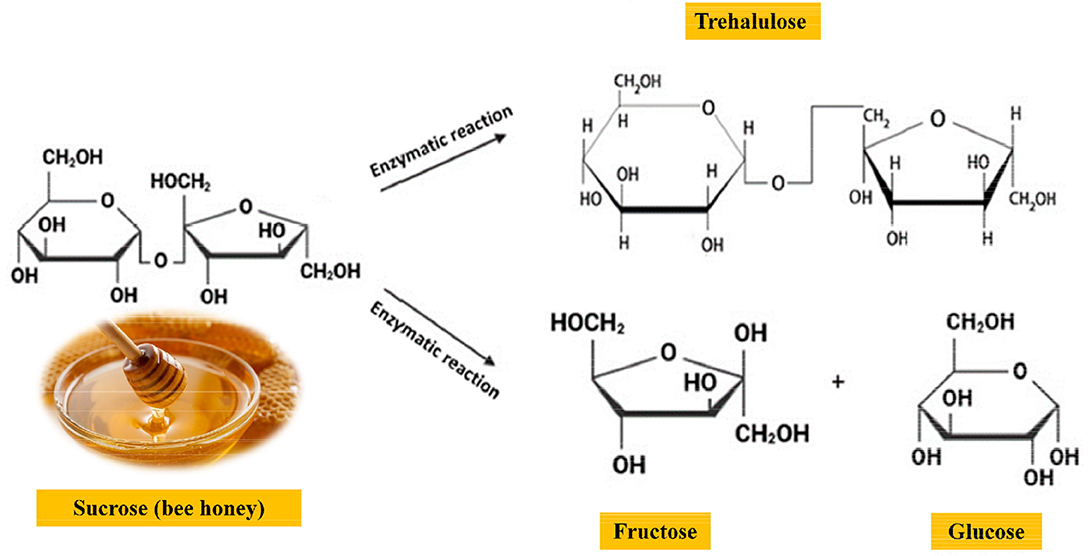
Figure 2. Mode of action of trehalose, fructose, and glucose formation in bee honey by enzymatic reaction.
Analyzing the sugar profile of honey is essential for determining its quality and spotting possible adulteration. The lack of measurable sucrose levels in the examined samples suggests that there was no adulteration, since a high sucrose concentration could indicate that commercial sugar was added (Al-Yahya et al., 2013; de Sousa et al., 2016). However, it is crucial to emphasize that the sugar profile of honey should not be the only factor used to identify adulteration. This is due to the possibility that bees may convert sucrose into trehalose when given it, producing honey with a sugar profile that is comparable to that of honey found naturally, but probably lacking other crucial elements that enhance honey's quality (Fletcher et al., 2021). Furthermore, the glucose level of premium honey usually decreases relative to the fructose content, a feature found in all bee honey samples examined (Julika et al., 2020).
One of the key markers is diastase activity, which measures honey freshness. The diastase activity of Sidr honey samples ranged from 6.1 to 14.3 g/100 g for Balady honey and Peshawar, respectively. The diastase levels of the samples in the current investigation were within an acceptable range. According to the Codex, honey has a minimum diastase activity of 8 diastase number (DN) or Gothe units, and 3 DN for honey with low natural enzyme content (Codex, 2022). Honey's storage conditions and heating process have an impact on diastase activity (Bako et al., 2019).
Antioxidant compounds and activity
Total phenols (TP) and total flavonoids (TF)
As shown in Table 3, the Sidr honey's photochemical, including TP and TF components, were assessed. Findings showed that the TP varied from 23.84 to 55.73 mg GA/g. Balady honey was determined to have the highest TP, while Peshawar honey had the lowest value. However, TF was the lowest 25.42 mg R/g of Al-Barri honey, while it was highest 40.66 mg R/g of Sidr Al-tamayoz honey. One study by Zawawi et al. (2022) conducted earlier research on TP in stingless bee honey and discovered that the range of TP for Australian honey was 88.3–132.0 mg GAE/100 g, while the range for Malaysian honey was 22.3–54.2 mg GAE/100 g. An additional investigation by Carina Biluca et al. (2021), the TP values for Brazilian bee honey ranged from 11.0 to 38.9 mg GAE/100 g. The variance in TP may also be a result of the samples' varying botanical origins in addition to being produced by various bee species (Mello dos Santos et al., 2024). Regarding TF, the results were in agreement with those noted by Hegazi et al. (2022), who found that flavonoid contents in Peshawar, Yemen, Punjab, and Saudi Arabia natural Sidr honey were 41.3, 38.13, 35.3, and 81.5 mg RE/100 g, respectively.

Table 3. Total phenolic (TP), total flavonoid (TF) contents and radical scavenging activity of Sidr honey samples (Mean ± SD).
DPPH scavenging activity
DPPH scavenging activity is one of the popular, rapid, and simple ways to evaluate honey's antioxidant activity and the ability of its ingredients to donate hydrogen or scavenge free radicals. A high DPPH is indicative of inhibiting lipid peroxidation, which enhances honey's potency as a therapeutic food. Table 4 also displays the average radical scavenging activity of the examined homey samples at different levels, i.e., 1.0, 2.5, and 5.0%. The DPPH scavenging capacity of the honey samples increased with the concentration of honey extract. The DPPH activity was increased up to a range of 43.02 and 62.68% at 5% for Balady and Sidr Al-tamayoz honey, respectively.

Table 4. Antibacterial efficacy of Sidr honey against food borne pathogens in vitro reported as inhibition zone (Mean ± SE).
The ability of various honey to scavenge DPPH was demonstrated by earlier studies. Miłek et al. (2021) found that the DPPH capacity of 16 different nectar and honeydew honey ranged from 10.82 to 79.37%. Al Qahtani et al. (2022) discovered that the DPPH scavenging activity of natural Saudi Sidr honey ranged from 1.28 to 1.59 Trolox equivalents/g ethanol and ethyl acetate extracts, respectively. However, Hegazi et al. (2022) calculated that the concentrated natural Sidr honey from Saudi Arabia, Yemen, Pakistan, and Peshawar had DPPH scavenging activities of 98.3, 95.0, 135.3, and 131.3 mg ascorbic acid/100 g honey, respectively. The differences in the honey samples' antioxidant activity could be caused by the changes in phenolic concentrations and distinct types of phenolic compounds present (Shamsudin et al., 2019). There are several factors that can influence honey's antioxidant activity, including the type and concentration of phenolic chemicals, geographical location, time of harvest, and environmental conditions (Cianciosi et al., 2018; Ávila et al., 2019). Furthermore, additional variables, including storage conditions, processing methods, and handling procedures, could affect the antioxidant properties of the honey (Abu et al., 2017).
Antibacterial efficacy of Sidr honey samples
The antibacterial efficacy of the Sidr samples was evaluated against various Gram-negative and Gram-positive pathogenic bacteria via the zone of inhibition, dehydrogenase activity, and the microbial growth curve.
The zone of inhibition
Table 4 and Figure 3 show the Sidr honey's capacity to suppress the growth of S. aureus, S. typhimurium, P. aeruginosa, and E. coli O157:H7. At a 25% concentration, all honey samples demonstrated varying degrees of bacterial growth inhibition. The range of inhibition zones for S. aureus, S. typhimurium, P. aeruginosa, and E. coli O157:H7 was 12–38 mm, 4.5–33.8 mm, and 15.8–34.0 mm, respectively. Peshawar Sidr showed the lowest inhibition of both E. coli and S. aureus. Al-Barri Sidr and Balady Sidr showed the least amount of inhibitory activity against P. aeruginosa and S. typhimurium, respectively. Furthermore, it was noted that S. typhimurium is not inhibited by Balady Sidr. Nevertheless, Sidr Al-tamayoz displayed the greatest inhibitory zones out of all the pathogen bacteria that were investigated. The outcomes concur with those published by Almasaudi et al. (2017) and Aljaghwani et al. (2021), who found that honey is more effective in inhibiting foodborne pathogens.
Honey's osmolarity is merely one of the several significant components that contribute to its antibacterial properties (Carnwath et al., 2014). These factors rely significantly on the nectar source for the bees, the flowers' location and associated weather, the storage period and circumstances, and the preservative treatment technique. Additionally, honey's chemical composition—which includes high sugar, low moisture, low water activity, low pH, and high phenolic content—prevents microbial growth (Figure 4).
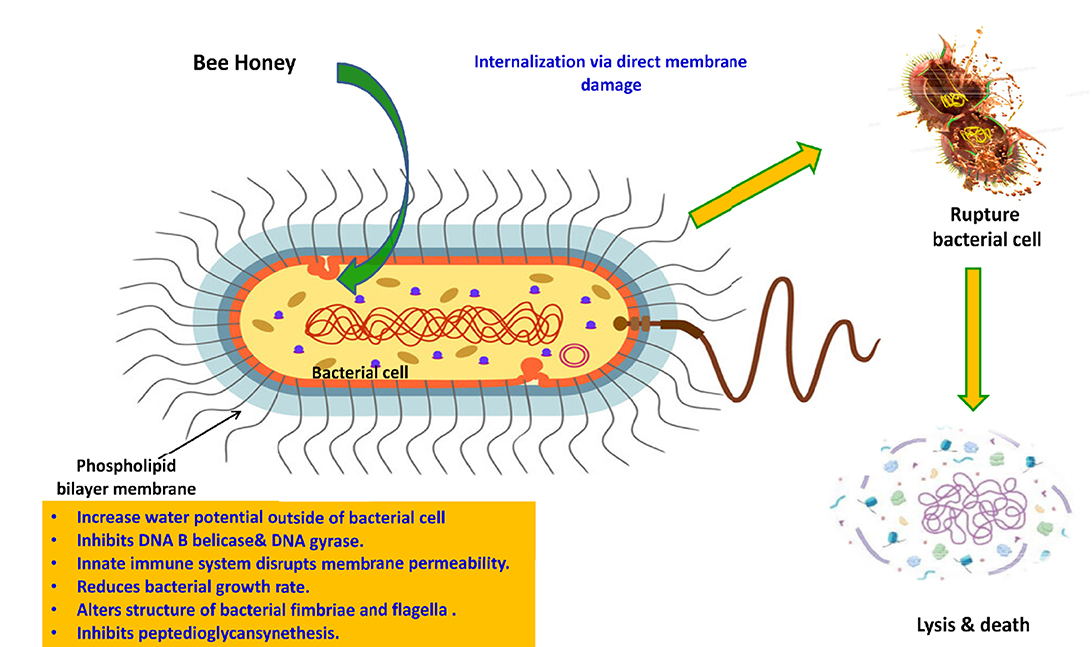
Figure 4. The mechanisms underlying the antibacterial efficacy of Sidr honey against microorganisms.
Microbial growth and dehydrogenase activity
This investigation evaluated the effect of Sidr honey samples on the growth response (bacterial count and dehydrogenase activity) of tested Gram-positive and Gram-negative bacteria. The number of cells was correlated with DAH as TF yield (μmol/mL), which was determined by optical density (OD600) (Burdock et al., 2011). For the bacterial count and dehydrogenase activity, the honey samples were administered at varying quantities and compared to the control (no honey added) during a range of incubation times (0, 12, 24, 36, and 48 h). Each graph in Figures 5−8 shows a honey sample at each of the four concentrations (15, 25, 50, and 75%) that were examined in conjunction with one pathogen and a control (no honey added). Figure 5 demonstrates that after 12 h of incubation, the number of S. aureus cells progressively declined and peaked after 48 h. Four samples of honey at different concentrations showed the same pattern of outcomes. At 25%, Sidr Al-tamayoz showed the largest decline, with a drop of ~99.9% (Figure 5d). Since the dilution of honey activates glucose oxidase, which oxidizes glucose to gluconic acid and H2O2, this result was consistent with the zone of inhibitory activity (Table 4) and may be the reason for the antibacterial activity (Mandal and Mandal, 2011). Furthermore, honey's antibacterial action is significantly influenced by its physiochemical characteristics.
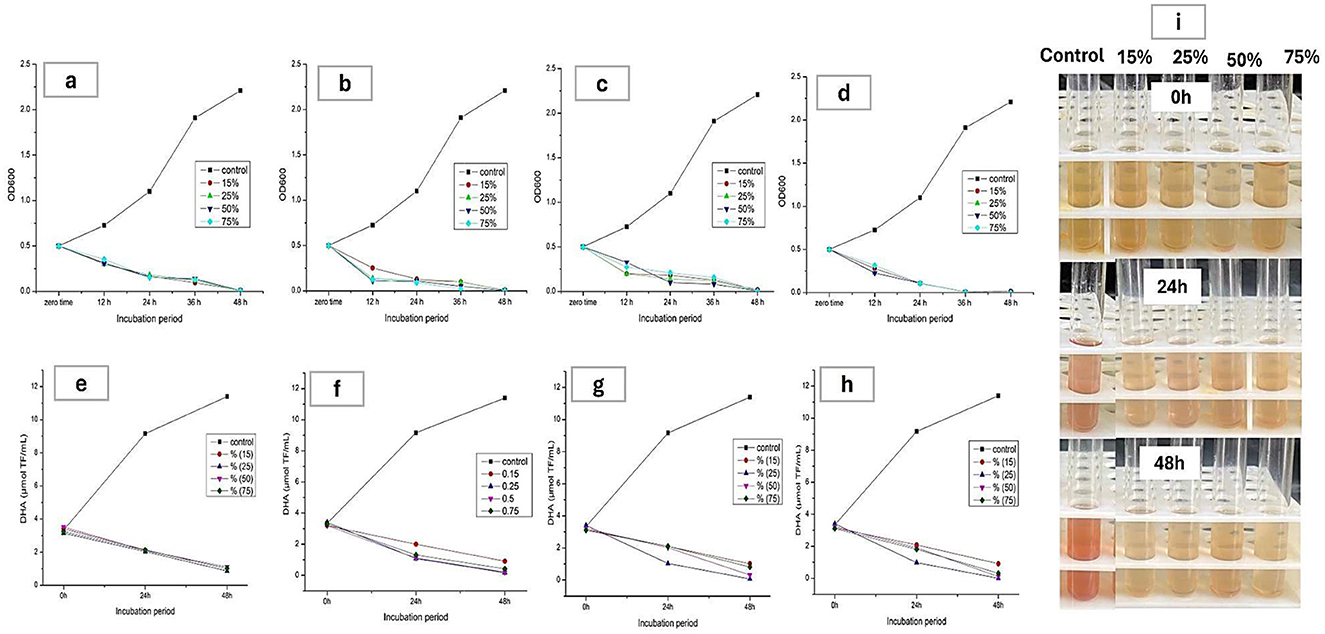
Figure 5. Microbial growth and dehydrogenase activity of S. aureus as affected by different concentrations of Sidr honey samples: (a) bacterial growth curve with S1; (b) bacterial growth curve with S2; (c) bacterial growth curve with S3; (d) bacterial growth curve with S4; (e) dehydrogenas activity with S1; (f) dehydrogenas activity with S2; (g) dehydrogenas activity with S3; (h, i) dehydrogenas activity with S4.
Sidr Al-tamayoz was the most efficient sample against S. typhimurium, followed by Peshawar Sidr, as shown in Figure 6. In general, the cell count dropped steadily after 12 h of incubation and peaked after 48 h (Figures 6a–d). Furthermore, after 48 h with any honey samples present at varying concentrations, the lowest DHA values were noted (Figures 6e–i). The addition of any honey samples had an impact on P. aeruginosa ‘s cell count and DHA. Sidr Al-tamayoz was the honey sample that inhibited development the most out of all of them, and the most effective concentration was 25% (Figures 7a–i).
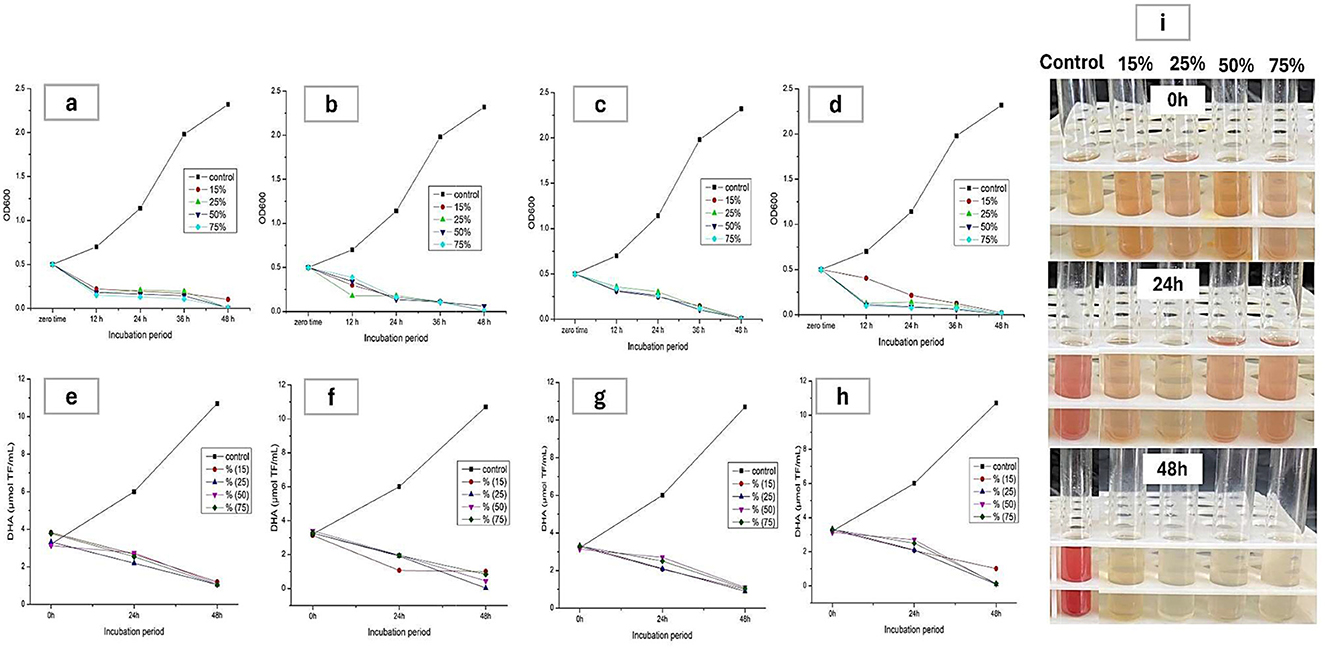
Figure 6. Microbial growth and dehydrogenase activity of S. typhimurium as affected by different concentrations of Sidr honey samples: (a) bacterial growth curve with S1; (b) bacterial growth curve with S2; (c) bacterial growth curve with S3; (d) bacterial growth curve with S4; (e) dehydrogenas activity with S1; (f) dehydrogenas activity with S2; (g) dehydrogenas activity with S3; (h, i) dehydrogenas activity with S4.
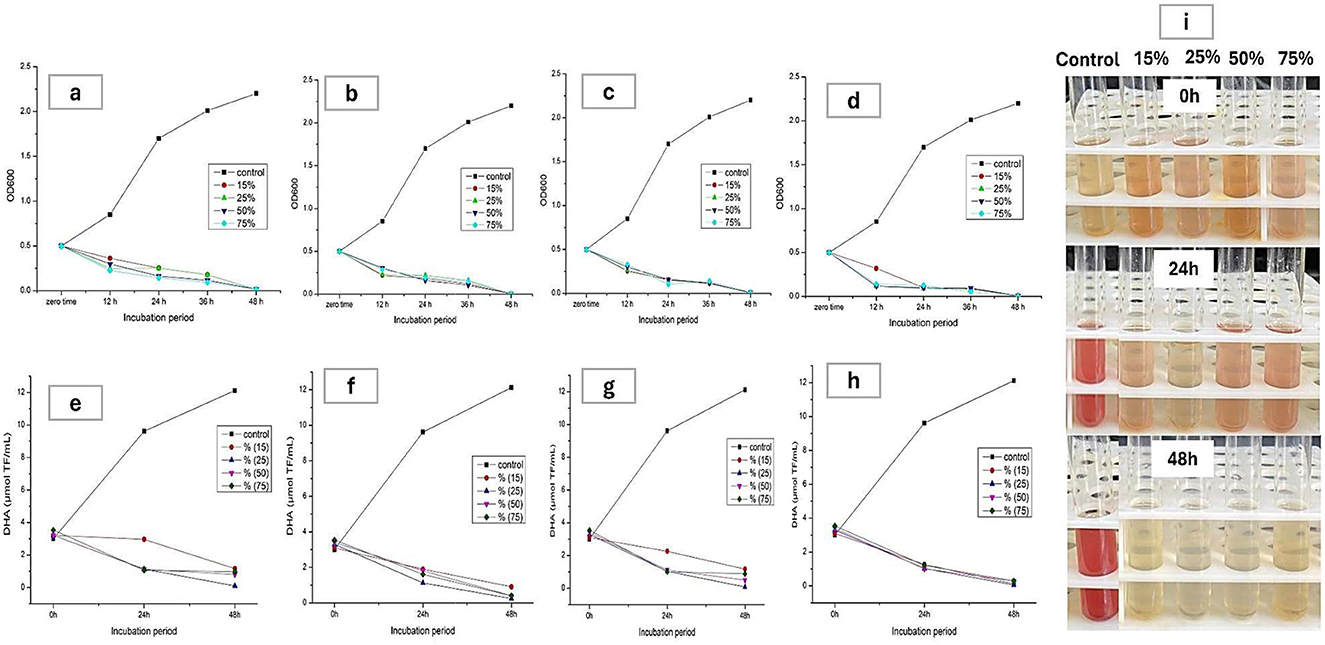
Figure 7. Microbial growth and dehydrogenase activity of P. aeruginosa as affected by different concentrations of Sidr honey samples: (a) bacterial growth curve with S1; (b) bacterial growth curve with S2; (c) bacterial growth curve with S3; (d) bacterial growth curve with S4; (e) dehydrogenas activity with S1; (f) dehydrogenas activity with S2; (g) dehydrogenas activity with S3; (h, i) dehydrogenas activity with S4.
Furthermore, Figure 8 demonstrates that the growth behavior of E. coli O157:H7 was impacted by all honey samples, particularly Sidr Al-tamayoz, which led to a notable reduction in both cell count and DHA (Figures 8a–i). In general, the presence of Sidr honey samples affected the cell count and DHA of all tested pathogens when compared with the control, when different amounts of honey were present, while the bacterial growth was increased logarithmically in the control (no honey added). The lowest growth rate (count and DHA) was observed after 48 h of incubating the bacteria with honey.
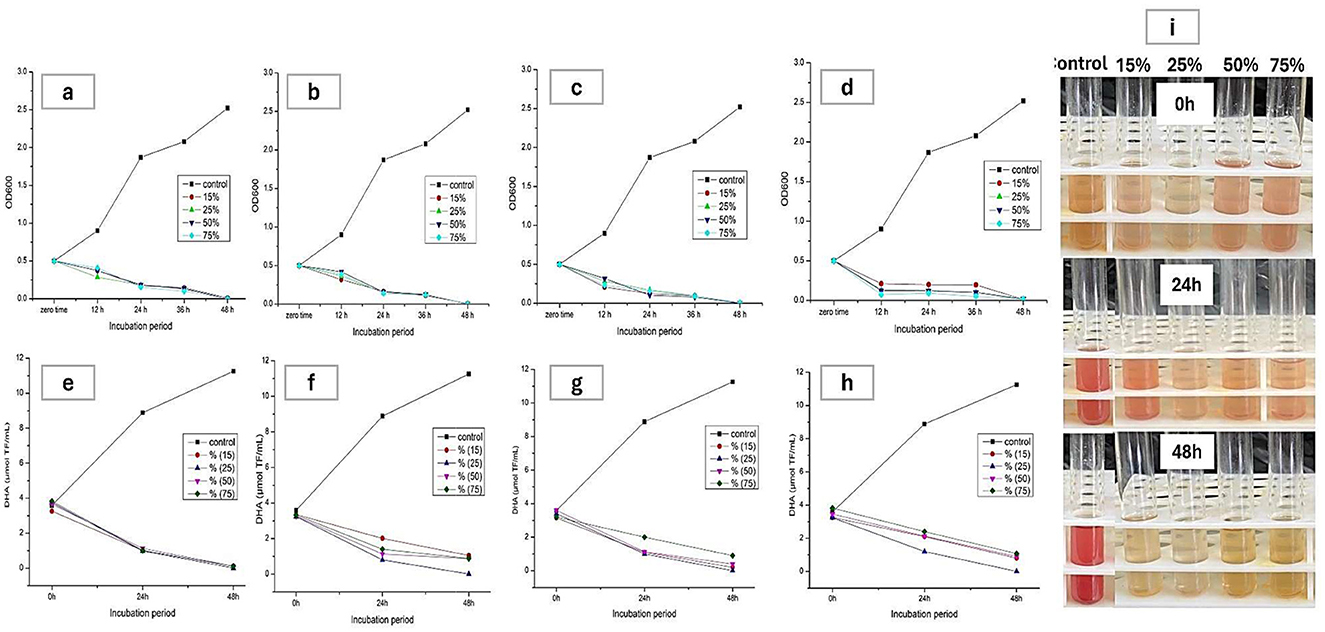
Figure 8. Microbial growth and dehydrogenase activity of E. coli O157:H7 as affected by different concentrations of Sidr honey samples: (a) bacterial growth curve with S1; (b) bacterial growth curve with S2; (c) bacterial growth curve with S3; (d) bacterial growth curve with S4; (e) dehydrogenas activity with S1; (f) dehydrogenas activity with S2; (g) dehydrogenas activity with S3; (h, i) dehydrogenas activity with S4.
Since the antibacterial compounds in the Sidr honey are based on their physicochemical properties, their antimicrobial activity varies due to the fresh, real honey (Hegazi et al., 2022). As a result, honey's antibacterial qualities are greatly enhanced by its total phenols and flavonoids. These substances may be more effective against a range of diseases at larger concentrations. Additionally, honey's organic acids may enhance its antioxidant capacity by binding to minerals, so boosting antioxidant phenolics, which in turn indirectly contribute to its antagonistic effect (Chua et al., 2013).
Furthermore, honey's phenolics can effectively suppress a variety of harmful bacteria by blocking their quorum-sensing mechanism (Takó et al., 2020). Pathogenic bacteria are known to produce biofilms through several methods. The most important of which is quorum sensing, which promotes cell attachment. Toxins from bacteria and pathogenic organisms that cause food poisoning and/or spoilage can be biologically controlled by inhibiting this signaling mechanism. Phenolics and oligosaccharides are important bioactive components of honey that possess antioxidant and antibacterial properties (Fyfe et al., 2017). Together with its nutritional advantages, Sidr honey's innate antibacterial qualities are enhanced by these qualities.
Conclusion
The study evaluated several physicochemical characteristics of Sidr Al-tamayoz honey, including pH, moisture content, electrical conductivity (EC), and sugar concentration. Most of these characteristics were found to align with the latest Codex Alimentarius honey guidelines, indicating good quality. Furthermore, the investigation into Sidr Al-tamayoz's bioactivity, demonstrated through its antioxidant activity and total phenolic content, suggests its potential as a readily accessible natural antioxidant. Notably, Sidr Al-tamayoz honey exhibited high levels of phenolic and flavonoid compounds, correlating with its strong antioxidant activity. Crucially, Sidr Al-tamayoz demonstrated superior antibacterial activity against all tested pathogenic bacteria (S. aureus, S. typhimurium, P. aeruginosa, and E. coli O157:H7), as evidenced by its significant inhibitory zones and impact on dehydrogenase activity. In summary, the findings robustly indicate that Sidr Al-tamayoz honey is a promising natural product, rich in bioactive compounds and antioxidants, offering potential health benefits.
Data availability statement
The raw data supporting the conclusions of this article will be made available by the authors, without undue reservation.
Author contributions
RE: Conceptualization, Investigation, Methodology, Writing – original draft. MM: Conceptualization, Formal analysis, Methodology, Writing – original draft, Data curation, Software. SK: Project administration, Resources, Supervision, Validation, Writing – original draft, Funding acquisition. SA: Project administration, Resources, Software, Supervision, Writing – review & editing, Funding acquisition, Visualization. MA: Software, Visualization, Writing – review & editing, Validation. SS: Conceptualization, Data curation, Supervision, Writing – review & editing, Methodology. EN: Investigation, Methodology, Software, Writing – original draft, Formal analysis.
Funding
The author(s) declare that no financial support was received for the research and/or publication of this article.
Acknowledgments
The authors wish to express their gratitude to Al-Asal Al-Barri Company for all the support provided.
Conflict of interest
SK was employed by Api Pharm Company, Consultant Al-Asal Al-Barri Company, and Al-Asal Al-Barri Company. SA was employed by Al-Asal Al-Barri Company.
The remaining authors declare that the research was conducted in the absence of any commercial or financial relationships that could be construed as a potential conflict of interest.
Generative AI statement
The author(s) declare that no Gen AI was used in the creation of this manuscript.
Publisher's note
All claims expressed in this article are solely those of the authors and do not necessarily represent those of their affiliated organizations, or those of the publisher, the editors and the reviewers. Any product that may be evaluated in this article, or claim that may be made by its manufacturer, is not guaranteed or endorsed by the publisher.
References
Abu, B., Sanusi, S., Abu, B., Cong, O., and Mian, Z. (2017). Physicochemical and antioxidant potential of raw unprocessed honey from Malaysian stingless bee. Pak. J. Nutr. 16, 888–894. doi: 10.3923/pjn.2017.888.894
Al Qahtani, H. W., Yagi, S., Yilmaz, M. A., Cakir, O., Tarhan, A., Mustafa, A. A., et al. (2022). Chemical profile, antioxidant and enzyme inhibition activities of natural Saudi Sidr and Talh honeys. Chem. Biodivers. 19:e202200227. doi: 10.1002/cbdv.202200227
Al-Farsi, M., Al-Belushi, S., Al-Amri, A., Al-Hadhrami, A., Al-Rusheidi, M., and Al-Alawi, A. (2018). Quality evaluation of Omani honey. Food Chem. 262, 162–167. doi: 10.1016/j.foodchem.2018.04.104
Aljaghwani, A., Allemailem, K. S., Aljaghwani, L. F., Alrumaihi, F., Joseph, R. J., Khan, A. A., et al. (2021). Antimicrobial effect of different types of honey on selected ATCC bacterial strains. Pharmacognosy J. 13, 217–225. doi: 10.5530/pj.2021.13.31
Almasaudi, S. B., Al-Nahari, A. A., El Sayed, M., Barbour, E., Al Muhayawi, S. M., Al-Jaouni, S., et al. (2017). Antimicrobial effect of different types of honey on Staphylococcus aureus. Saudi J. Biol. Sci. 24, 1255–1261. doi: 10.1016/j.sjbs.2016.08.007
Alqurashi, A., Masoud, E., and Alamin, M. (2013). Antibacterial activity of Saudi honey against Gram negative bacteria. J. Microbiol. Antimicrob. 5, 1–5. doi: 10.5897/JMA2012.0235
Al-Yahya, M., Mothana, R., Al-Said, M., Al-Dosari, M., Al-Musayeib, N., Al-Sohaibani, M., et al. (2013). Attenuation of CCl4-induced oxidative stress and hepatonephrotoxicity by Saudi Sidr honey in rats. Evid. Based Complement. Altern. Med. 2013:569037. doi: 10.1155/2013/569037
Amariei, S., Norocel, L., and Scripcă, L. A. (2020). An innovative method for preventing honey crystallization. Innov. Food Sci. Emerg. Technol. 66:102481. doi: 10.1016/j.ifset.2020.102481
AOAC (2016). Official Methods of Analysis of AOAC International, 20th Edn. Gathersburg, MD: AOAC International.
Ávila, S., Hornung, P. S., Teixeira, G. L., Malunga, L. N., Apea-Bah, F. B., Beux, M. R., et al. (2019). Bioactive compounds and biological properties of Brazilian stingless bee honey have a strong relationship with the pollen floral origin. Food Res. Int. 123, 1–10. doi: 10.1016/j.foodres.2019.01.068
Bako, T., Mamai, E. A., and Bature, B. J. (2019). Determination of quality parameters of honey from Taraba State, Nigeria. Chem. Biomol. Eng. 4, 1–9. doi: 10.11648/j.cbe.20190401.11
Bertoncelj, J., Doberšek, U., Jamnik, M., and Golob, T. (2007). Evaluation of the phenolic content, antioxidant activity and colour of Slovenian honey. Food Chem. 105, 822–828. doi: 10.1016/j.foodchem.2007.01.060
Betta, E., Vit, P., Meccia, G., Pedro, S. R., Romano, A., Khomenko, I., et al. (2024). “Volatile and sensory profile of cerumen, plant resin deposit, and propolis of a Tetragonisca angustula (Latreille 1811) Nest from Merida, Venezuela,” in Stingless Bee Nest Cerumen and Propolis, Vol. 2 (Cham: Springer Nature Switzerland), 149–179.
Bicudo de Almeida-Muradian, L., Monika Barth, O., Dietemann, V., Eyer, M., Freitas, A. S., and Martel, A.-C. (2020). Standard methods for Apis mellifera honey research. J. Apic. Res. 59, 1–62. doi: 10.1080/00218839.2020.1738135
Bouddine, T., Kachmar, M. R., Akdad, M., Bouymajane, A., Ajebli, M., Mothana, R. A., et al. (2024). Authentication of Ziziphus lotus honey from the Middle Atlas Mountains of Morocco: physicochemical properties, mineral content, sugar, polyphenol profiles, and antioxidant capacity. ACS Omega 9, 44956–44973. doi: 10.1021/acsomega.4c04284
Burdock, T., Brooks, M., and Ghaly, A. (2011). A dehydrogenase activity test for monitoring the growth of Streptomyces venezuelae in a nutrient rich medium. J. Bioprocess. Biotech. 1, 1–10. doi: 10.4172/2155-9821.1000101
Carina Biluca, F., Braghini, F., de Campos Ferreira, G., Costa dos Santos, A., Helena Baggio Ribeiro, D., Valdemiro Gonzaga, L., et al. (2021). Physicochemical parameters, bioactive compounds, and antibacterial potential of stingless bee honey. J. Food Process. Preserv. 45:e15127. doi: 10.1111/jfpp.15127
Carnwath, R., Graham, E., Reynolds, K., and Pollock, P. (2014). The antimicrobial activity of honey against common equine wound bacterial isolates. Vet. J. 199, 110–114. doi: 10.1016/j.tvjl.2013.07.003
Chakir, A., Romane, A., Marcazzan, G. L., and Ferrazzi, P. (2016). Physicochemical properties of some honeys produced from different plants in Morocco. Arab. J. Chem. 9, S946–S954. doi: 10.1016/j.arabjc.2011.10.013
Chua, L. S., Rahaman, N. L. A., Adnan, N. A., and Eddie Tan, T. T. (2013). Antioxidant activity of three honey samples in relation with their biochemical components. J. Anal. Methods Chem. 2013:313798. doi: 10.1155/2013/313798
Cianciosi, D., Forbes-Hernández, T. Y., Afrin, S., Gasparrini, M., Reboredo-Rodriguez, P., Manna, P. P., et al. (2018). Phenolic compounds in honey and their associated health benefits: a review. Molecules 23:2322. doi: 10.3390/molecules23092322
Codex (2022). Standard for Honey. Available online at: https://www.fao.org/fao-who-codexalimentarius/sh-proxy/en/?lnk=1andurl=https%253A%252F%252Fworkspace.fao.org%252Fsites%252Fcodex%252FStandards%252FCXS%2B12-1981%252FCXS_012e.pdf (Accessed April 24, 2025).
Dar, S. A., Farook, U. B., Rasool, K., and Ahad, S. (2024). “Honey: classification, composition, safety, quality issues and health benefits,” in Advanced Techniques of Honey Analysis (Netherlands: Elsevier), 1–37.
de Sousa, J. M. B., de Souza, E. L., Marques, G., de Toledo Benassi, M., Gullón, B., Pintado, M. M., et al. (2016). Sugar profile, physicochemical and sensory aspects of monofloral honeys produced by different stingless bee species in Brazilian semi-arid region. Lwt 65, 645–651. doi: 10.1016/j.lwt.2015.08.058
Doughari, J. (2006). Antimicrobial activity of Tamarindus indica Linn. Trop. J. Pharm. Res. 5, 597–603. doi: 10.4314/tjpr.v5i2.14637
El-Seedi, H. R., El-Wahed, A. A. A., Salama, S., Agamy, N., Altaleb, H. A., Du, M., et al. (2024). Natural remedies and health; a review of bee pollen and bee bread impact on combating diabetes and obesity. Curr. Nutr. Rep. 13, 751–767. doi: 10.1007/s13668-024-00567-3
Faleiros-Quevedo, M., Silva, G. R., Dos Santos, A. N., and Francoy, T. M. (2025). Honey from different species of stingless bees (Apidae: Meliponini) is effective against gram-positive and gram-negative bacteria. J. Med. Food 28, 198–204. doi: 10.1089/jmf.2023.0107
FAO (2024). Food and Agriculture Organization of the United Nations; Honey and Beeswax. Available online at: https://www.fao.org/forestry/nwfp/statistics/honey-and-beeswax/en (Accessed March 15, 2025).
Fletcher, M., Hungerford, N., and Smith, T. (2021). Optimising Bioactive Content of Australian Stingless Bee Honey. Wagga Wagga, NSW: AgriFutures.
Fyfe, L., Okoro, P., Paterson, E., Coyle, S., and McDougall, G. J. (2017). Compositional analysis of Scottish honeys with antimicrobial activity against antibiotic-resistant bacteria reveals novel antimicrobial components. LWT Food Sci. Technol. 79, 52–59. doi: 10.1016/j.lwt.2017.01.023
Guerzou, M., Aouissi, H. A., Guerzou, A., Burlakovs, J., Doumandji, S., and Krauklis, A. E. (2021). From the beehives: identification and comparison of physicochemical properties of Algerian honey. Resources 10:94. doi: 10.3390/resources10100094
Hamoda, M. E., Elmeihy, R. M., Fouad, M. T., Abou-Aly, H. E., and Zaghloul, R. A. (2021). Preserving efficiency of sausage inoculated with listeria monocytogenes by ginger extract. Ann. Agric. Sci. Moshtohor 59, 111–122. doi: 10.21608/ASSJM.2021.182370
Hao, Z., Chen, R., Chai, C., Wang, Y., Chen, T., Li, H., et al. (2022). Antimicrobial peptides for bone tissue engineering: diversity, effects and applications. Front. Bioeng. Biotechnol. 10:1030162. doi: 10.3389/fbioe.2022.1030162
Hegazi, A. G., Al Guthami, F. M., Al Gethami, A. F., Abd Allah, F. M., Saleh, A. A., and Fouad, E. A. (2017). Potential antibacterial activity of some Saudi Arabia honey. Vet. World 10:233–237. doi: 10.14202/vetworld.2017.233-237
Hegazi, A. G., Al Guthami, F. M., Ramadan, M. F., Al Gethami, A. F., Craig, A. M., and Serrano, S. (2022). Characterization of Sidr (Ziziphus spp.) honey from different geographical origins. Appl. Sci. 12:9295. doi: 10.3390/app12189295
Ibrahim, A. S., Sukor, R., Anwar, F., Murugesu, S., Selamat, J., and Siva, R. (2024). Nutritional, nutraceutical attributes, microbiological and chemical safety of different varieties of dates—a review. Fut. Foods 10:100421. doi: 10.1016/j.fufo.2024.100421
Islam, M. K., Sostaric, T., Lim, L. Y., Hammer, K., and Locher, C. (2020). Sugar profiling of honeys for authentication and detection of adulterants using high-performance thin layer chromatography. Molecules 25:5289. doi: 10.3390/molecules25225289
Jaradat, Z., Khataybeh, B., Al Ghzawi, A. M., Ababneh, Q., and Al Nabusli, A. (2022). Molecular identification of major bacteria in honey and the effect of microwave treatment on its microbial quality and antibacterial activity. AIMS Agric. Food 7, 594–613. doi: 10.3934/agrfood.2022037
Julika, W., Ajit, A., Ismail, N., Aqilah, N., Naila, A., and Sulaiman, A. (2020). “Sugar profile and enzymatic analysis of stingless bee honey collected from local market in Malaysia”, in: IOP Conference Series: Materials Science and Engineering (London: IOP Publishing).
Khataybeh, B., Jaradat, Z., and Ababneh, Q. (2023). Anti-bacterial, anti-biofilm and anti-quorum sensing activities of honey: a review. J. Ethnopharmacol. 317:116830. doi: 10.1016/j.jep.2023.116830
Kumar, R. (2024). “Historical and religious perspective of honey,” in Honey (Boca Raton, FL: CRC Press), 1–16.
Luca, L., Pauliuc, D., and Oroian, M. (2024). Honey microbiota, methods for determining the microbiological composition and the antimicrobial effect of honey–a review. Food Chem. X 23:101524. doi: 10.1016/j.fochx.2024.101524
Luca, L., Pauliuc, D., Ursachi, F., and Oroian, M. (2025). Physicochemical parameters, microbiological quality, and antibacterial activity of honey from the Bucovina region of Romania. Sci. Rep. 15:4358. doi: 10.1038/s41598-025-88613-0
Mandal, M. D., and Mandal, S. (2011). Honey: its medicinal property and antibacterial activity. Asian Pac. J. Trop. Biomed. 1, 154–160. doi: 10.1016/S2221-1691(11)60016-6
Mashal, T. F., Omar, R. E., Khattab, M. M., and Nowar, E. E. (2023). Determination of some Effects of different feeding treatments on honeybee drones (Apis Mellifera l.). Ann. Agric. Sci. Moshtohor 61, 521–530. doi: 10.21608/assjm.2023.315274
Mello dos Santos, M., Khan, N., Lim, L. Y., and Locher, C. (2024). Antioxidant activity, physicochemical and sensory properties of stingless bee honey from Australia. Foods 13:1657. doi: 10.3390/foods13111657
Miłek, M., Bocian, A., Kleczyńska, E., Sowa, P., and Dżugan, M. (2021). The comparison of physicochemical parameters, antioxidant activity and proteins for the raw local Polish honeys and imported honey blends. Molecules 26:2423. doi: 10.3390/molecules26092423
Moreira, R., Trugo, L., Pietroluongo, M., and De Maria, C. (2002). Flavor composition of cashew (Anacardium occidentale) and marmeleiro (Croton species) honeys. J. Agric. Food Chem. 50, 7616–7621. doi: 10.1021/jf020464b
Naik, R. R., Gandhi, N. S., Thakur, M., and Nanda, V. (2019). Analysis of crystallization phenomenon in Indian honey using molecular dynamics simulations and artificial neural network. Food Chem. 300:125182. doi: 10.1016/j.foodchem.2019.125182
Ogwu, M. C., and Izah, S. C. (2025). Honey as a natural antimicrobial. Antibiotics 14:255. doi: 10.3390/antibiotics14030255
Omran, N. S., Hassan, M. M., Abdel-rahman, M. F., and Desoky, A. E.-A. S. (2023). Some physicochemical properties of Egyptian Sidr bee honey in Upper Egypt. J. Sohag Agrisci. 8, 319–328. doi: 10.21608/JSASJ.2023.334769
Pauliuc, D., Ciursă, P., Ropciuc, S., Dranca, F., and Oroian, M. (2021). Physicochemical parameters prediction and authentication of different monofloral honeys based on FTIR spectra. J. Food Compos. Anal. 102:104021. doi: 10.1016/j.jfca.2021.104021
Predanócyová, K., and Šedík, P. (2024). Honey market challenges: flavored honey as healthy food choice for consumers. J. Microbiol. Biotechnol. Food Sci. 13, 11021–11021. doi: 10.55251/jmbfs.11021
Rosa, A. A., Soares, J. P. G., Junqueira, A. M. R., Rosa, A. G., and de Sousa Moreira, I. (2024). Conventional and organic honey production and quality: a worldwide perspective. Rev. Gest. Soc. Ambient. 18, 1–31. doi: 10.24857/rgsa.v18n8-069
Roshan, A.-R. A., Gad, H. A., El-Ahmady, S. H., Abou-Shoer, M. I., Khanbash, M. S., and Al-Azizi, M. M. (2017). Characterization and discrimination of the floral origin of sidr honey by physicochemical data combined with multivariate analysis. Food Anal. Methods 10, 137–146. doi: 10.1007/s12161-016-0563-x
Sanz, M. L., Del Castillo, M. D., Corzo, N., and Olano, A. (2003). 2-Furoylmethyl amino acids and hydroxymethylfurfural as indicators of honey quality. J. Agric. Food Chem. 51, 4278–4283. doi: 10.1021/jf021235s
Schade, J., Marsh, G., and Eckert, J. (1958). Diastase activity and hydroxy-methyl-furfural in honey and their usefulness in detecting heat alteration. J. Food Sci. 23, 446–463. doi: 10.1111/j.1365-2621.1958.tb17592.x
Shamsudin, S., Selamat, J., Sanny, M., Abd. Razak, S.-B., Jambari, N. N., Mian, Z., et al. (2019). Influence of origins and bee species on physicochemical, antioxidant properties and botanical discrimination of stingless bee honey. Int. J. Food Properties 22, 239–264. doi: 10.1080/10942912.2019.1576730
Shapla, U. M., Solayman, M., Alam, N., Khalil, M. I., and Gan, S. H. (2018). 5-Hydroxymethylfurfural (HMF) levels in honey and other food products: effects on bees and human health. Chem. Cent. J. 12, 1–18. doi: 10.1186/s13065-018-0408-3
Shraim, A. M., Ahmed, T. A., Rahman, M. M., and Hijji, Y. M. (2021). Determination of total flavonoid content by aluminum chloride assay: a critical evaluation. Lwt 150:111932. doi: 10.1016/j.lwt.2021.111932
Suto, M., Kawashima, H., and Nakamura, Y. (2020). Determination of organic acids in honey by liquid chromatography with tandem mass spectrometry. Food Anal. Methods 13, 2249–2257. doi: 10.1007/s12161-020-01845-w
Taha, E.-K. A., Al-Kahtani, S., and Taha, R. (2021). Comparison of the physicochemical characteristics of sidr (Ziziphus spp.) honey produced by Apis florea F. and Apis mellifera L. J. Apicult. Res. 60, 470–477. doi: 10.1080/00218839.2020.1746036
Takó, M., Kerekes, E. B., Zambrano, C., Kotogán, A., Papp, T., Krisch, J., et al. (2020). Plant phenolics and phenolic-enriched extracts as antimicrobial agents against food-contaminating microorganisms. Antioxidants 9:165. doi: 10.3390/antiox9020165
Wilczyńska, A., and Żak, N. (2024). Polyphenols as the main compounds influencing the antioxidant effect of honey—a review. Int. J. Mol. Sci. 25:10606. doi: 10.3390/ijms251910606
Xie, Y., and Coghi, P. (2025). The multifaceted health benefits of honey: a natural antimicrobial, antioxidant, and complementary therapeutic agent. Microbes Immunity 2, 1–15. doi: 10.1016/j.jtcms.2025.03.015
Yang, W., Zhang, C., Li, C., Huang, Z. Y., and Miao, X. (2019). Pathway of 5-hydroxymethyl-2-furaldehyde formation in honey. J. Food Sci. Technol. 56, 2417–2425. doi: 10.1007/s13197-019-03708-7
Zawawi, N., Zhang, J., Hungerford, N. L., Yates, H. S., Webber, D. C., Farrell, M., et al. (2022). Unique physicochemical properties and rare reducing sugar trehalulose mandate new international regulation for stingless bee honey. Food Chem. 373:131566. doi: 10.1016/j.foodchem.2021.131566
Zhang, J., Hungerford, N. L., Yates, H. S., Smith, T. J., and Fletcher, M. T. (2022). How is Trehalulose formed by Australian stingless bees?-an intermolecular displacement of nectar sucrose. J. Agric. Food Chem. 70, 6530–6539. doi: 10.1021/acs.jafc.2c01732
Keywords: Sidr honey, mixed honey, antibacterial activity, physiochemical, antioxidant activity
Citation: El-Meihy RM, Morsy MK, Kasem SI, Aljuweer SAM, Abdelaziz M, Saddeek S and Nowar EE (2025) Physicochemical properties, antibacterial activity, and antioxidant capacity of mixed Sidr honey from Saudi Arabia. Front. Sustain. Food Syst. 9:1631572. doi: 10.3389/fsufs.2025.1631572
Received: 19 May 2025; Accepted: 30 June 2025;
Published: 24 July 2025.
Edited by:
Vinay Kumar Pandey, Manav Rachna International Institute of Research and Studies (MRIIRS), IndiaReviewed by:
Batool Khataybeh, Jordan University of Science and Technology, JordanRiesta Primaharinastiti, Airlangga University, Indonesia
Copyright © 2025 El-Meihy, Morsy, Kasem, Aljuweer, Abdelaziz, Saddeek and Nowar. This is an open-access article distributed under the terms of the Creative Commons Attribution License (CC BY). The use, distribution or reproduction in other forums is permitted, provided the original author(s) and the copyright owner(s) are credited and that the original publication in this journal is cited, in accordance with accepted academic practice. No use, distribution or reproduction is permitted which does not comply with these terms.
*Correspondence: Mohamed K. Morsy, bW9oYW1lZC5hYmRlbGhhZmV6QGZhZ3IuYnUuZWR1LmVn
 Rasha M. El-Meihy
Rasha M. El-Meihy Mohamed K. Morsy
Mohamed K. Morsy Sobhy I. Kasem3,4
Sobhy I. Kasem3,4 Salma Saddeek
Salma Saddeek